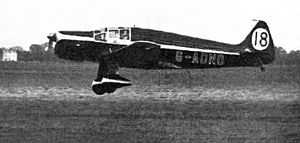de Havilland T.K.2
| T.K.2 | |
|---|---|
 | |
| De Havilland T.K.2 (G-ADNO), starting in the London-Cardiff race, at Heston 10 September 1938 | |
| Role | Racer |
| National origin | United Kingdom |
| Manufacturer | de Havilland |
| First flight | 16 August 1935 |
| Retired | 1947 |
| Number built | 1 |
|
| |
The de Havilland T.K.2 was a British 1930s single-engined monoplane, designed by students of the de Havilland Aeronautical Technical School. It won two races before World War II, and afterwards set a class closed circuit speed record.
Development
The de Havilland Aeronautical Technical School was set up in 1928, to enhance de Havilland's apprenticeship scheme.[1] From 1933, the students designed aircraft, and the best of these were built. The drawings for the first one were done by a Dutch student, Juste van Hattum who entitled it the T.K.1, with T.K. for "Tekniese Kollege". Three T.K. aircraft were built and flown, the T.K.1, the T.K.2, and the T.K.4.[2] They did not receive DH. style type numbers.
The T.K.2 was designed as a high speed tourer, under the leadership of Marcus Langley, the school's instructor in design. It was a single-engined, two-seat low cantilever wing monoplane, with an enclosed cockpit and fixed spatted undercarriage. It first flew on 16 August 1935 at Hatfield Aerodrome, piloted by Hubert S. Broad, and powered by a 147 hp (110 kW) de Havilland Gipsy Major inverted inline engine. Subsequently, for racing purposes, the passenger seat was usually replaced with an additional fuel tank.[2][3]
In late 1935 or early 1936, it received a more aerodynamically refined canopy, and spats extended rearwards.[4] In 1938, it flew with wings clipped by 4 ft (1.22 m) to 28 ft 0 in (8.53 m) and re-engined with a 140 hp (104 kW) de Havilland Gipsy Major II.[2] At the same time, the forward canopy section was revised again, its sides extended downwards below the rear cockpit rim. Post-WWII, it flew with a Gipsy Major 10 engine. The aircraft was not intended for production, and only one T.K.2 was built. It was test flown on various occasions under 'B conditions' with identities E-3, E-5 and E-0235, but otherwise carried the official registration G-ADNO.[4]
Operational history
The T.K.2 led an active racing life between 1936 and 1939. It made a speciality of the annual Heston-Cardiff race. In its original form, it won the race on 19 September 1936, piloted by Robert J. Waight at 189.7 mph (305.2 km/h)[3][5] On 10 July 1937, it won the race, piloted by Geoffrey de Havilland, Jr. at 161.5 mph (259.7 km/h)).[2][3][6] After the wing clipping and the new engine, on 10 September 1938, it won the race piloted by Geoffrey de Havilland Jnr. at 187.5 mph (301.6 km/h)[2][7] On 3 July 1937, it came second in another cross-country race, from Heston to Newcastle.[8]
On 7 September 1935, it came in fourth in the King's Cup Race at Hatfield,[9] but on 11 July 1936, it could only finish sixth.[10] It did rather better on the Isle of Man, where on 6 June 1938 it came fourth in the Manx Air Derby.[3][11] On 27 May 1939, it won the race from Hatfield to the Isle of Man, and on 29 May 1939 it came fifth in the Manx Air Derby[3][12]
On 30 July 1938, it came third in the Folkestone Trophy race at Lympne, where it was awarded a £10 prize, presented by the dramatist Noël Coward.[3][13] It also took part in the 1937 Cinque Ports Wakefield Trophy.[14]
During WWII, it was used as a de Havilland company communications aircraft.[2] Post-WWII, it returned to the Isle of Man to gain second place at the Manx Air Derby on 26 May 1947.[3][15] Powered with a Gipsy Major 10, it set a 100 km (62 m) class closed circuit record on 31 August 1947 at 178.3 mph (286.9 km/h), piloted by W.P.I Fillingham.[2][16][17] It was scrapped in December 1947.[2]
Specifications (initial configuration)
Data from Jackson 1978, p. 526
General characteristics
- Crew: 2
- Length: 22 ft 5 in (6.83 m)
- Wingspan: 32 ft 0 in (9.75 m)
- Wing area: 125 ft2 (11.6 m2)
- Empty weight: 1,049 lb (476 kg)
- Gross weight: 1,600 lb (726 kg)
- Powerplant: 1 × de Havilland Gipsy Major air-cooled inverted 4-cylinder inline, 147 hp (110 kW)
Performance
- Maximum speed: 182 mph (293 km/h)
Notes
- ↑ Jackson 1978, pp. 26–30
- ↑ 2.0 2.1 2.2 2.3 2.4 2.5 2.6 2.7 Jackson 1978, p. 526
- ↑ 3.0 3.1 3.2 3.3 3.4 3.5 3.6 Lewis 1970
- ↑ 4.0 4.1 Jackson 1988, pp. 321–322
- ↑ Flight 24 September 1936 p.317 1936 London-Cardiff race
- ↑ Flight 15 July 1937 p.83 1937 London Cardiff race
- ↑ Flight 15 September 1938 p.239 1938 London-Cardiff race
- ↑ Flight 8 July 1937 p.59 London Newcastle race
- ↑ Flight 12 September 1935 p.264 1935 Kings Cup
- ↑ Flight 16 July 1936 p.28A 1936 Kings Cup
- ↑ Manx Air Race 1938
- ↑ Manx Air Race 1939
- ↑ Flight 4 August 1938 p.239 1938 Folkestone Trophy
- ↑ Flight 2 July 1937 p.228 1937 Wakefield Trophy Image
- ↑ Flight 29 May 1947 p.239 1947 Manx Derby
- ↑ Flight 4 September 1947 p.239 Folkestone Trophy
- ↑ Flight 9 October 1947 p.409 Closed circuit record
References
| Wikimedia Commons has media related to De Havilland T.K.2. |
- Jackson, A.J. (1978). de Havilland Aircraft since 1909. London: Putnam Publishing. ISBN 0-370-30022-X.
- Jackson, A.J. (1988). British Civil Aircraft 1919-59: Volume 3. London: Putnam Publishing. ISBN 0-85177-818-6.
- Lewis, Peter (1970). British Racing and Record-Breaking Aircraft. London: Putnam Publishing. ISBN 0-370-00067-6.
| ||||||||||||||||||||||||||||||||||||
| ||||||||||||||||||||||